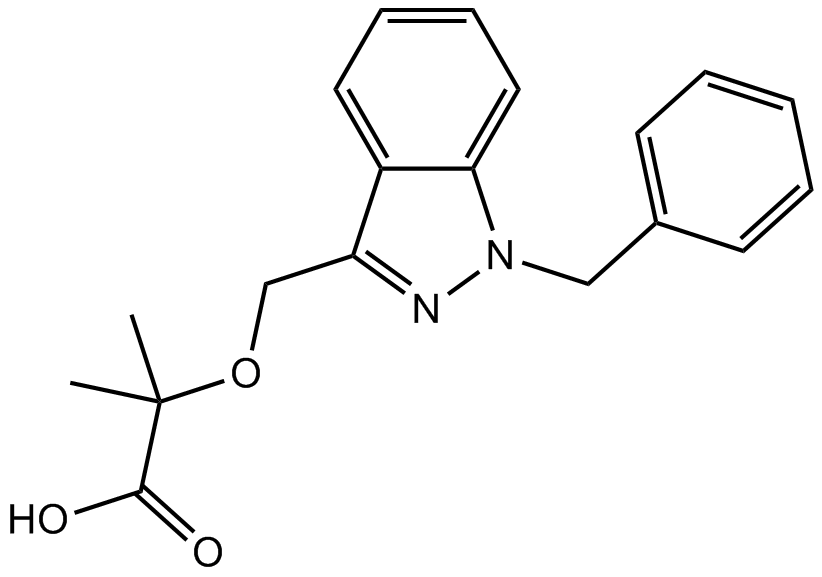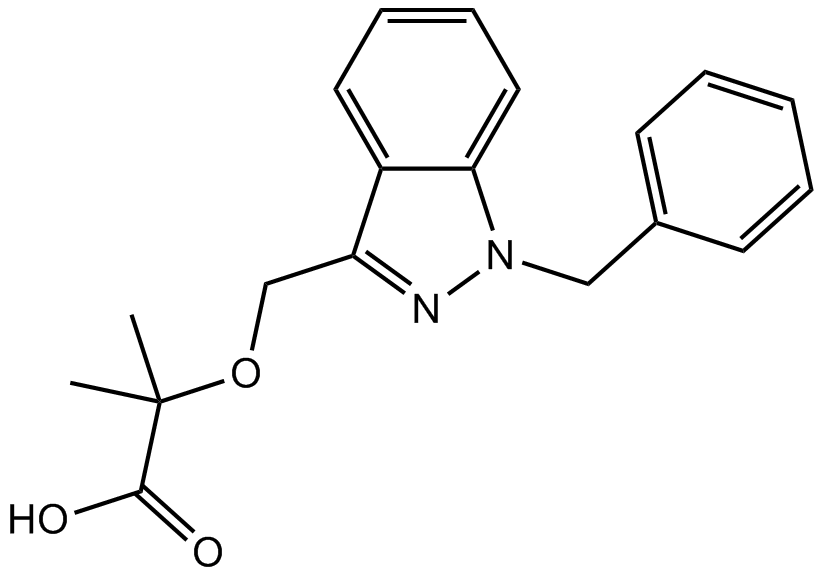Bindarit
Bindarit(AF-2838), an anti-inflammatory agent, is a selective inhibitor againstmonocyte chemotactic proteins MCP-1/CCL2, MCP-3/CCL7 and MCP-2/CCL8[1].
MCP-1, MCP-2, and MCP-3 are inflammatory mediators that specifically stimulate the directional migration of T cells as well as monocytes and may play an important role in immune cell recruitment into sites of antigenic challenge [2].
In vitro: Bindarit inhibited MCP-1 and TNF-alpha production induced in monocytes by LPS and Candida albicans in a dose-dependent manner with the IC50 of 172 µM and 403 µM, respectively.The inhibition of LP-induced MCP-1 production by Bindarit has been associated with the reduced levels of MCP-1 mRNA transcripts with the IC50 value of 75 µM. Bindaritexihibited an inhibitory effect in the production of MCP-1 by LPS-stimulated MM6 cells with an IC50 of 425 μM, without affecting the release of IL-8 or IL-6[3].Administration of bindarit (10-300 μM) reduced rat vascular smooth muscle cell (VSMC) proliferation, migration, and invasion[4].
In vivo: In NZB/W mice model with lupus nephritis, oral treatment of bindarit prolonged survival and delayed the onset of proteinuria [3]. In rats treated with bindarit (200 mg/kg/day), bindarit resulted in a 39% reduction of balloon injury-induced neointima formation at day 14 without affecting re-endothelialization. Bindarit reduced the number of medial and neointimal proliferating cells at day 7 by 54 and 30%, respectively. In hypercholesterolaemicapoE(-/-) mice, administration of bindarit reduced the number of proliferating cells by 42%at day 7 after carotid injury and inhibited of neointima formation by 47% at day 28. In neointimal lesions of apoE(-/-) mice treated with bindarit, data analysis of the cellular composition showed that the relative content of macrophages and the number of VSMCs were reduced by 66 and 30%, respectively, compared with the control group[4].
References:
[1]. Zoja C, Corna D, Benedetti G, et al. Bindarit retards renal disease and prolongs survival in murine lupus autoimmune disease[J]. Kidney international, 1998, 53(3): 726-734.
[2]. Taub D D, Proost P, Murphy W J, et al. Monocyte chemotactic protein-1 (MCP-1),-2, and-3 are chemotactic for human T lymphocytes[J]. Journal of Clinical Investigation, 1995, 95(3): 1370.
[3]. Sironi M, Guglielmotti A, Polentarutti N, et al. A small synthetic molecule capable of preferentially inhibiting the production of the CC chemokine monocyte chemotactic protein-1[J]. European cytokine network, 1999, 10(3): 437-442.
[4]. Grassia G, Maddaluno M, Guglielmotti A, et al. The anti-inflammatory agent bindarit inhibits neointima formation in both rats and hyperlipidaemicmice[J]. Cardiovascular research, 2009, 84(3): 485-493.
| Physical Appearance | A solid |
| Storage | Store at -20°C |
| M.Wt | 324.37 |
| Cas No. | 130641-38-2 |
| Formula | C19H20N2O3 |
| Solubility | insoluble in H2O; ≥16.2 mg/mL in DMSO; ≥2.96 mg/mL in EtOH |
| Chemical Name | 2-[(1-benzylindazol-3-yl)methoxy]-2-methylpropanoic acid |
| SDF | Download SDF |
| Canonical SMILES | CC(C)(C(O)=O)OCc1n[n](Cc2ccccc2)c2c1cccc2 |
| Shipping Condition | Small Molecules with Blue Ice, Modified Nucleotides with Dry Ice. |
| General tips | We do not recommend long-term storage for the solution, please use it up soon. |
| Cell experiment [1]: | |
|
Cell lines |
Rat vascular smooth muscle cells (VSMCs) |
|
Preparation method |
The solubility of this compound in DMSO is > 16.2 mg/mL. General tips for obtaining a higher concentration: Please warm the tube at 37 °C for 10 minutes and/or shake it in the ultrasonic bath for a while. Stock solution can be stored below - 20 °C for several months. |
|
Reacting condition |
10 ~ 300 μM |
|
Applications |
At the doses of 100 and 300 μM, Bindarit significantly inhibited PDGF-BB-induced rat VSMC proliferation by 27% and 42%, respectively. Moreover, in VSMCs stimulated with PDGF-BB, Bindarit (10 ~ 300 μM) inhibited MCP-1 production in a concentration-dependent manner. |
| Animal experiment [1]: | |
|
Animal models |
ApoE-/- mice |
|
Dosage form |
100 mg/kg; p.o.; b.i.d. |
|
Applications |
In ApoE-/- mice, Bindarit significantly reduced the number of PCNA-positive cells as well as neointimal area. In neointimal lesion, Bindarit also reduced the relative content of F4/80-positive macrophages and the number of VSMCs by 66% and 30%, respectively. |
|
Other notes |
Please test the solubility of all compounds indoor, and the actual solubility may slightly differ with the theoretical value. This is caused by an experimental system error and it is normal. |
|
References: [1]. Grassia G, Maddaluno M, Guglielmotti A, et al. The anti-inflammatory agent bindarit inhibits neointima formation in both rats and hyperlipidaemicmice[J]. Cardiovascular research, 2009, 84(3): 485-493. |
|
Quality Control & MSDS
- View current batch:
Chemical structure









